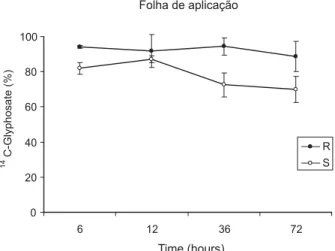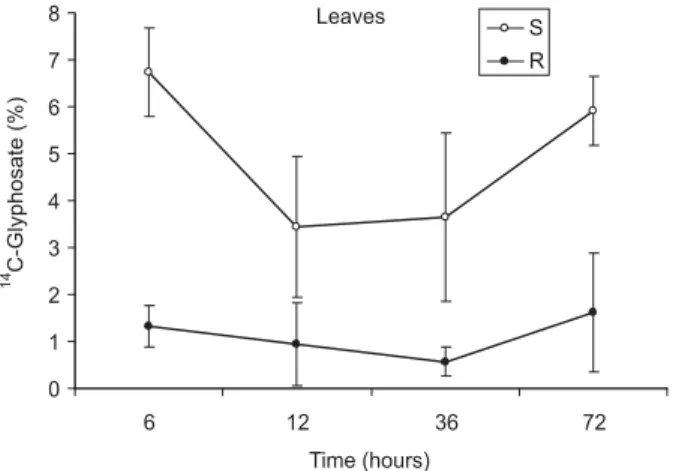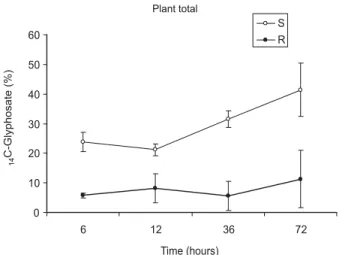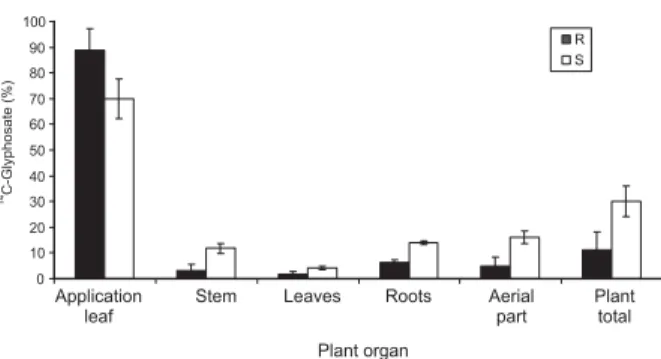G
LYPHOSATET
RANSLOCATION INH
AIRYF
LEABANE(C
onyza bonariensis
) B
IOTYPES1Translocação do Glyphosate em Biótipos de Buva (Conyza bonariensis)
FERREIRA, E.A.2, GALON, L.3, ASPIAZÚ, I.3, SILVA, A.A.4, CONCENÇO, G.3, SILVA, A.F.3, OLIVEIRA, J.A.5 and VARGAS, L.6
ABSTRACT - The objective of this work was to evaluate the translocation of glyphosate in
C. bonariensis plants resistant and susceptible to that herbicide. The 14C-glyphosate was mixed
with commercial gyhphosate (800 g ha-1) and applied on the center of the adaxial face of a third
node leaf, using a micro syringe, and adding 10 µL of a solution with specific activity of 1,400 Bq, 45 days after plant emergence. The concentration of the glyphosate translocated in the plant was evaluated at time intervals of 6, 12, 36 and 72 hours after being applied on the application leaf, stem, roots and leaves. Ten hours after treatment application, the distribution of the product in the application leaf, divided into base, center and apex, was also evaluated by measuring the radiation emitted by 14C-glyphosate in a liquid scintillation spectrometer. Greater glyphosate retention was
observed in the resistant biotype leaf, approximately 90% of the total absorbed up to 72 hours. In the susceptible biotype, this value was close to 70% in the same period. Susceptible biotype leaves, stem and roots showed greater concentration of glyphosate, indicating greater translocation efficiency in this biotype. In the resistant biotype, the herbicide accumulated in greater quantity at the apex and center of the application leaf, while in the susceptible biotype greater accumulation was observed at the base and center leaf. Thus, it can be stated that the resistance mechanism is related to the differential translocation of this herbicide in the biotypes.
Keywords: herbicides, radiochemical, resistance, translocation.
RESUMO - Objetivou-se com este trabalho avaliar a translocação do glyphosate em plantas de C. bonariensis resistentes e suscetíveis a esse herbicida. Para isso aplicou-se o 14 C-glyphosate em mistura com C-glyphosate comercial (800 g ha-1) sobre o centro da face adaxial da folha do terceiro nó, utilizando-se uma microsseringa, adicionando-se 10 µL da calda com atividade específica de 1.400 Bq, aos 45 dias após a emergência da buva. A concentração de glyphosate translocado na planta foi avaliada em intervalos de tempo de 6, 12, 36 e 72 horas após a aplicação, na folha de aplicação, no caule, nas raízes e nas folhas. Dez horas após a aplicação dos tratamentos (HAT) avaliou-se também a distribuição do produto na folha de aplicação, dividida em base, centro e ápice. As avaliações foram realizadas por meio da medição da radiação emitida pelo 14C-glyphosate, em espectrômetro de cintilação líquida. Maior retenção de glyphosate foi observada na folha tratada do biótipo resistente, aproximadamente 90 % do total absorvido até as 72 horas. No biótipo suscetível esse valor foi de cerca de 70 % no mesmo período. Nas folhas, no caule e nas raízes, a maior concentração do glyphosate absorvido foi encontrada no biótipo suscetível, indicando maior eficiência de translocação neste biótipo. No biótipo resistente o herbicida se acumulou em maior quantidade no ápice e no centro da folha de aplicação e no suscetível observou-se maior acúmulo na base e no centro da mesma folha. Desta forma, pode-se afirmar que o mecanismo de resistência está relacionado à translocação diferencial deste herbicida nos biótipos.
Palavras-chave: herbicidas, radioquímico, resistência, translocação.
1 Recebido para publicação 1.10.2007 e na forma revisada 29.5.2008.
2 Pós-Doutorando, Dep. de Fitotecnia da Universidade Federal de Viçosa (DFT-UFV), <evanderalves@yahoo.com.br>; 3 Doutorandos DFT-UFV; 4 Professor DFT-UFV; 5 Professor DBG-UFV; 6 Pesquisador Embrapa Trigo-Passo Fundo-RS,
INTRODUCTION
The herbicide glyphosate belongs to the chemical group of amino acid synthesis inhibitors and contains the N-(phosphonomethyl) glycine as active ingredient (Bridges, 2003). After being absorbed by the plants, it is readily translocated, along with the photosynthates, from the point of application located on the leaves to distant drains. In sensitive plants, glyphosate inhibitis the activity of the plastidic enzyme 5-enolpiruvilshikimate-3-phosphate synthase (EPSPs), responsible for the reaction that condenses shikimate-3-phosphate and phosphoenolpyruvate in 5-enolpiruvilshikimate-3-phosphate (EPSP) and inorganic phosphate (Pi), in the pre-chorismate step of the shikimate route (Shaner & Bridges, 2003). The shikimate route is absent in animals, but it plays a fundamental role in the metabolism of plants, fungi and bacteria for the biosynthesis of the aromatic essential amino acids phenylalanine, tyrosine and tryptophan, and other important secondary compounds, such as auxin and allelochemicals (Hinchee et al., 1993). It is estimated that over 20 % of all photosynthesis-fixed carbon runs through that route, designed for the synthesis of aromatic amino acids (Devine et al., 1993).
Glyphosate has been used intensively in agriculture worldwide for about 30 years, being the most commercialized herbicide in the world, today. Thus, abusive use (several applications on transgenic soybean in the same season), has currently caused 10 weed species (Amaranthus palmeri, Amaranthus rudis, Ambrosia artemisiifolia, Eleusine indica, Conyza bonariensis, Conyza canadensis, Lolium multiflorum, Euphorbia heterophylla, Sorghum halepense and Plantago lanceolata) to develop resistance in some biotypes (Weed Science, 2008).
The hairy fleabane (Conyza bonariensis) is originated from the United States (Weaver et al., 2001) and belongs to the Asteraceae family, with an annual development cycle. It is an extremely prolific species and can produce up to 200.000 viable seeds per plant and establish itself under different weather conditions. The plants show good adaptability
in systems considered soil conservationists, such as tillage, minimum tillage and orchard areas (Bhowmik & Bekech, 1993). Self-pollination, along with a large production of easily dispersible seeds, are factors that can contribute to good ecological adaptability, survival of resistant hairy fleabane biotypes, and high infestation in conservation systems (Moreira et al., 2007).
Due to ease of dispersion, combined with competitiveness (Kissmann & Groth, 1992) hairy fleabane control in annual winter crops, such as soybean, corn and cereals, is basically carried out with specific or non-selective herbicides. In wheat crop, hairy fleabane can be controlled with 2,4-D and chlorimuron-ethyl, while in soybean and corn crops, it can be controlled mainly with the use of glyphosate, in desiccation during crop pre-sowing. Glyphosate was used in these crops as an efficient way of desiccation during pre-sowing, showing an effective hairy fleabane control, even at advanced stages of vegetative growth (Vargas et al., 2007). However, in recent years, hairy fleabane control using glyphosate is no longer satisfactory, which led to the suspicion that the species acquired resistance, a fact that was later confirmed by Moreira et al. (2007) Thus, further studies are needed to identifying resistance mechanism developed by the species and to define new strategies for its management.
It is known that, when absorbed, the herbicide should be translocated by it the vascular tissues into the target-sites, where will exert its activity (Satichivi et al., 2000). Translocation is an essential process for herbicide effectiveness (Wanamarta & Penner, 1989).Glyphosate moves into the phloem, following the route of photosynthesis products from the photo-synthetically active leaves (source), towards the growing parts of the plants (drain) for metabolism maintenance and/or formation of reserve products, roots, tubers, young leaves and meristem areas (Hetherington et al., 1998). Thus, changes in herbicide absorption, metabolism and translocation may affect the sensitivity of a plant, as it needs to reach the site of action at an appropriate concentration.
C. bonariensis, resistant and susceptible to this herbicide, aiming at elucidating the resistance mechanism of the biotype, and develop techniques for the management of this species in crops where glyphosate lost efficiency control of this weed.
MATERIAL AND METHODS
Resistant and susceptible hairy fleabane biotypes (Conyza bonariensis), collected in RR soybean farms in the state of Rio Grande do Sul-Brazil, were grown displaying a heavy use of glyphosate. The experiment was mounted in pots containing 200 mL of substrate, composed of soil and washed sand in the proportion of 3:1 and fertilized in a growth chamber at day/night temperature of 25/ 21 oC, respectively, and 12 hours of light
photoperiod, using a completely randomized design, with four repetitions. At 45 days after hairy fleabane emergence (one plant per pot),
14C-glyphosate was applied in combination
with commercial glyphosate (800 g ha-1) on the
center of the adaxial face of the third leaf node, using a micro-syringe, and adding 10 µL of a
solution with a specific activity of approximately 1.400 Bq.
The translocation of 14C-glyphosate in the
resistant and susceptible biotypes was assessed at different time intervals (6, 12, 36 and 72 hours after treatment with the product). After each period of exposure, the plants were collected and fractioned into application leaf, stem, leaves and roots. The application leaf was washed with 9.0 mL of methanol to remove the non-absorbed product. Ten hours after treatment with 14C-glyphosate, the application
leaves were divided into three parts (base, middle and apex). All plant material was stove-dried at 50 oC for 48 hours to obtain dry mass
of each component. Next, each component was ground to a texture equivalent to 200 mesh. Samples of 100 mg dry mass of each plant component (application leaf, stems, leaves and roots) were placed in 20 ml bottles, for counting, and homogenized with 1 mL of Triton-X-100 for 10 seconds in vortex, added 5 mL of scintillation cocktail, and again subjected to homogenization. The bottles were placed in a Beckman 6500 liquid scintillation spectrometer, for automatic quenching correction.
The 14C-glyphosate radiation values of the
plant were converted into a percentage of the total in the plant, distributed in the treated leaf, stems, leaves and roots. The application leaf values were transformed into percentage of the total contained in this leaf, distributed in the apex, center and base. The results were presented in graphs, using the observed means and standard deviations.
RESULTS AND DISCUSSION
A greater accumulation of glyphosate was observed in the application leaf of the resistant biotype in relation to the susceptible biotype at all the time intervals evaluated. At 72 hours after treatment application (HTA), approximately 90 % of the glyphosate remained in the application leaf of the resistant biotype and around 69% in the susceptible biotype (Figure 1). Feng et al. (2004), Koger & Reddy (2005) and Dinelli et al. (2006), working with biotypes of Conyza canadensis resistant and susceptible to glyphosate, found greater retention of the product in the application leaves of the resistant biotype. Ferreira et al. (2006) found that in the resistant biotype of Lolium multiflorum, 64 hours after product application, approximately 81.64 % of the total absorbed was retained in the leaf where 14
C-glyphosate had been applied, while in the sensitive biotype, retention was around 54.66 %. Greater glyphosate retention in the leaf of
Figure 1 - Percentage of 14C-glyphosate in the application leaf
the resistant biotype of Lolium rigidum was also reported by Lorraine-Colwill et al. (2003).
Glyphosate is one of the few herbicides that transpose the plasma membrane through a protein carrier. The phosphate carriers, contained in the plasmalema, are able to bind to molecules of this herbicide and transport them to the cytoplasm (Dennis & Deltorot, 1993). In general, a high glyphosate retention occurs in leaves that have received the treatment, with this fact being likely due to the action of the product, which disrupts the carbon cycle in the chloroplast, reducing carbohydrate synthesis, its transport to the drains and, consequently, glyphosate transport (McAllister & Haberlie, 1985; Satichivi et al., 2000). Glyphosate movement is associated with the carbohydrates that govern the distribution of the herbicide on the plant, as a greater accumulation of that herbicide occurs in the shoot tips and roots (McAllister & Haberlie, 1985).
At 6 HTA, it was observed that approximately 8% of the absorbed product was in the stem of the susceptible biotype plants; at 72 HTA, that value reached around 16%. In the resistant biotype, the translocation of the marked herbicide had values close to 2% at all the time intervals studied (Figure 2). After 6 HTA, around 7% of the 14C-glyphosate
absorbed by the application leaf had moved into the other leaves of the susceptible biotype; this value was reduced at 12 and 36 HTA to around
4%, and again increasing after 72 HTA (Figure 3). This variation in the concentration of the product in the leaves, along time, may be related to its re-translocation to other parts of the plant (Santos et al., 2007). In the resistant biotype, the concentration of the marked product did not exceed 2% for all the time intervals assessed (Figure 3). These results show greater glyphosate translocation into the susceptible biotype. Ferreira et al. (2006), working with glyphosate-resistant and -susceptible ryegrass biotypes (Lolium multiflorum), found the occurrence of greater accumulation of the product on leaves of the susceptible biotype, compared to the resistant, after 32 HTA.
The susceptible hairy fleabane biotype showed higher concentration of glyphosate in its roots at 6 HTA, around 10 % in the susceptible biotype and less than 2 % in the resistant biotype; in the susceptible biotype, there was an increase in the concentration of the product at the time intervals assessed, surpassing the 20 % at 72 HTA. In the resistant biotype, product concentration did not exceed 5 % during the 72 hours of evaluation (Figure 4). The results indicate that glyphosate moves too fast through the plant, regardless of the biotype, and this movement is associated with speed of sugar transport in the phloem, which is high, and, in general, can vary from 0.3 to 1.5 m h-1 (Taiz & Zeiger, 2004). Feng et
al. (2004), Koger & Reddy (2005) and Dinelli et
Figure 2 - Percentage of 14C-glyphosate in the stem of resistant
(R) and susceptible (S) C. bonariensis biotypes, in relation to the total product absorbed by the plant.
Figure 3 - Percentage of 14C-glyphosate in the leaves of
al. (2006) observed the same behavior of the product in Conyza canadensis biotypes. Lorraine-Colwill et al. (2003) found, after 48 hours of 14C-glyphosate application,
accumulation of 6 and 20 % in the roots of resistant and susceptible biotypes, respectively, in Lolium rigidum plants. Ferreira et al. (2006), working with ryegrass (Lolium multiflorum) biotypes, also found that the susceptible biotype showed greater accumulation of the herbicide at all evaluation intervals; at 64 HTA, the values observed by these authors were about 5 and 30 % for the resistant and the susceptible biotypes, respectively.
When assessing the amount of glyphosate in the shoot, which was the sum of the concentration of this product in the stem and leaves, it was verified that the susceptible biotype accumulated about four times more than the resistant one at 72 HTA (Figure 5). In the resistant biotype, the concentration of the product did not exceed 5% during all assessment periods. Again, the results demonstrate greater efficiency of the susceptible biotype in glyphosate translocation.
The total product in the plant was the sum of the percentage of the entire product, in relation to the amount absorbed by the application leaf, contained in leaves, stem and roots (except for the application leaf). This variable indicates the amount of product translocated from the application leaf into the other parts of the plant. When assessing
Figure 6, it is observed that, at all intervals, the concentration of glyphosate translocated from the application leaf into the other parts of the plant was greater in the susceptible biotype than in the resistant one. Approximately 40 % of the absorbed product moved into the other parts of the plant in the susceptible biotype at 72 HTA, and around 9 % in the resistant one, in the same assessment.
Figure 7 shows the percentage of the product in the plant organs at 72 HTA. It was observed that at the end of the evaluation, the amount of glyphosate translocated by the resistant biotype was lower than that by the
Figure 4 - Percentage of 14C-glyphosate in the roots of resistant
(R) and susceptible (S) C. bonariensis biotypes, in relation to the total product absorbed by the plant.
Figure 5 - Percentage of 14C-glyphosate in the shoot of resistant
(R) and susceptible (S) C. bonariensis biotypes, in relation to the total product absorbed by the plant.
Figure 6 - Percentage of 14C-glyphosate in the plant, except
HTA. In the resistant biotype, the product seemed to be accumulating in greater quantity at the center and at the apex of the leaf. On the other hand, there was greater movement of the product towards the base of the leaf in the susceptible biotype (Figure 8). Lorraine-Colwill et al. (2003), working with glyphosate-resistant and susceptible Lolium rigidum biotypes, also found greater herbicide accumulation at the center and at the apex of the application leaf of the resistant biotype.
Figure 7 - Percentage of 14C-glyphosate in relation to the total
absorbed present in C. bonariensis plants 72 DAT. R resistant biotype, S susceptible biotype.
susceptible. The latter showed greater efficiency in the distribution of the product by all the organs of the plant. Approximately 40% of the product absorbed by the application leaf translocated into the other parts of the plant in the susceptible biotype, and around 10 % translocated in the resistant biotype.
As it can be seen in Figure 7, even in the susceptible biotype, product accumulation occurred in the application leaf. However, this accumulation is more significant in the resistant biotype, where there is less loading of the product in sieve elements of the phloem. Thus, a weed that has as a mechanism of resistance to glyphosate a change in the herbicide site of action would not necessarily present product accumulation in the application leaf, when compared to its susceptible similar. Several studies on glyphosate-resistant biotypes showed greater accumulation of the herbicide in the application leaf, as observed in the species Coniza bonariensis (Feng et al., 2004; Koger et al., 2005; Dinelli et al., 2006), Lolium multiflorum (Ferreira et al., 2006) and Lolium rigidum (Lorraine-Colwill et al., 2003).
When assessing the percentage of glyphosate in parts of the application leaf (apex, center and base), it was verified that in the resistant biotype, around 40% of the product was at the apex and center of the application leaf and approximately 19% at the base of the leaf, at 10 HTA. In the susceptible biotype, the concentration of glyphosate had fallen to around 20% at the apex, with its highest concentration being observed in the center and on the base of the application leaf at 10
The results of this work suggest that C . b o n a r i e n s i s biotypes show relevant differences regarding the translocation of 14
C-glyphosate. Thus, it can be stated that the resistance mechanism is related to the differential translocation of the herbicide in the biotypes. There was a lower product distribution rate in the resistant biotype, with a greater accumulation of the product being observed in the treated leaf. In the susceptible biotype, a greater accumulation was found in the shoot (leaves and stems) and roots.
LITERATURE CITED
BHOWMIK, P. C.; BEKECH, M. M. Horseweed (Conyza canadensis) seed production, emergence and distribution in no-tillage and conventional-tillage corn (Zea mays). Agronomy, v. 11, n. 2, p. 67-71, 1993.
DENNIS, M. H.; DELPOT, S. Carrier-mediated uptake of glyphosate in broad bean (Vicia faba) via a phosphate transporter. Physiol. Plant., v. 87, n. 3, p. 569-575, 1993.
DEVINE, M.; DUKE, S. O.; FEDTKE, C. Inhibition of aromatic amino acid synthesis. In: Physiology herbicide action. Englewood Cliffs: Prentice Hall, 1993. p. 252-263. Figure 8 - Percentage of 14C-glyphosate in parts of the
DINELLI, G. et al. Physiological and molecular insight on the mechanisms of resistance to glyphosate in Conyza canadensis (L.) Cronq. Biotypes. Pest, Bioc. Phys., v. 86, n. 1, p. 30-41, 2006.
FENG, P. C. C. et al. Investigations into glyphosate-resistant horseweed (Conyza canadensis): retention, uptake, translocation, and metabolism. Weed Sci., n. 52, n. 4, p. 498-505. 2004.
FERREIRA, E. A. et al. Translocação do glyphosate em biótipos de azevém (Lolium multiflorum). Planta Daninha, v. 24, n. 2, p. 365-370, 2006.
HINCHEE, M. A. W. et al. Herbicide-tolerant crops. In: KUNG, S.; WU, R. (Eds.). Transgenic plants. San Diego: Academic Press, 1993. p. 243-263.
HETHERINGTON, P. et al.The absorption, translocation and distribution of the herbicide glyphosate in maize expressing the CP-4 transgene. J. Exper. Bot., v. 50, p. 1567-1576, 1998.
KISSMANN, K. G.; GROTH, D. Plantas infestantes e
nocivas. São Paulo: Basf Brasileira, 1992. Tomo II. 798 p.
KOGER, H.; REDDY, K. N. Role of absorption and translocation n the mechanism of glyphosate resistance in horserweed (Conyza canadensis). Weed Sci.,v. 53, n. 1, p. 84-89, 2005
LORRAINE-COLWILL, D. F. et al. Investigations into the mechanism of glyphosate resistance in Lolium rigidum. Pest. Biochem. Physiol., v. 74, n. 1, p. 62-72, 2003.
MCALLISTER, R.; HABERLIE, L. L. Translocation of 14 C-glyphosate and 14CO
2 – Labeled photoasimilates in canada thistle (Cirsium arvense). Weed Sci., v. 33, n. 1, p. 153-159, 1985.
MOREIRA, M. S. et al. Resistência de Conyza canadensis e C. bonariensis ao herbicida glyphosate. Planta Daninha, v. 25, n. 1, p. 157-164, 2007.
SANTOS, J. B. et al. Efeito de formulações na absorção e translocação do glyphosate em soja transgênica. Planta Daninha, v. 25, n. 1, p. 165-172, 2007 .
SATICHIVI, N. et al. Absorption and translocation of glyphosate isopropylamine and trimethysulfonium salts in Abutilon theophrasti and Setaria faberi. Weed Sci., v. 48, n. 6, p. 675-679, 2000.
SHANER, D.; BRIDGES, D. Inhibitors of aromatic amino acid biosyntesis (glyphosate). In: SHANER, D.; BRIDGES, D. Herbicide action course. West Lafayette: Purdue University, 2003. p. 514-529, 2004.
TAIZ, L.; ZEIGER, E. Fisiologia vegetal. 3.ed. São Paulo: 2004. 719 p.
VARGAS, L. et al. Buva (Conyza bonariensis) resistente ao glyphosate na região sul do brasil. Planta Daninha, v. 25, n. 3, p. 573-578, 2007.
WANAMARTA, G. D.; PENNER, D. Foliar absorption of herbicides. Weed Sci., v. 4, n. 2, p. 215-231, 1989.
WEAVER, S. E. The biology of Canadian weeds, Conyza canadensis. Can. J. Plant Sci., v. 81, p. 867-875, 2001.



